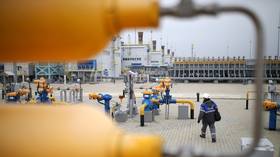 FILE PHOTO: The Russkaya Compressor Station of the TurkStream gas pipeline, Anapa, Russia’s Krasnodar Region. © Sputnik / Vitaly Timkiv
FILE PHOTO: The Russkaya Compressor Station of the TurkStream gas pipeline, Anapa, Russia’s Krasnodar Region. © Sputnik / Vitaly Timkiv
Russian gas supplies to the EU via the TurkStream pipeline soared by over 40% in the first seven months of this year compared to the same period in 2023, Vedomosti has reported, citing gas transmission data.
Russian fuel is in high demand due to heat waves in Europe and Asia, the publication noted.
In July, Russian state energy giant Gazprom delivered over 1.5 billion cubic meters (bcm) of gas to the EU via TurkStream, which was 29% more than in the previous month, the newspaper wrote, citing data from European gas transmission group Entsog. Year-on-year the deliveries jumped by 9%, it stated.
TurkStream is a natural gas pipeline that runs from Russia to Türkiye via the Black Sea and then continues to the border with EU member Greece. The other route for Russian pipeline gas to reach the bloc is via the transit system in Ukraine.
Gazprom was once the EU’s main gas supplier. However, following the start of the conflict between Kiev and Moscow, it dramatically reduced its exports to the bloc due to Western sanctions and the sabotage of the Nord Stream pipelines.
The EU has also resolved to reduce its dependence on Russian pipeline gas and increase purchases of liquefied natural gas (LNG) instead, primarily from the US.
American suppliers reportedly reduced shipments to the EU in July, sending their LNG tankers to higher-paying regions in Asia instead, according to Bloomberg. Last month, the US shipped more of its seaborne gas to Asian consumers than during any month since 2021, the outlet said, adding that demand in the region had surged due to hot weather.
READ MORE: Dutch MPs sound alarm over surging imports of Russian gasUkraine-related sanctions introduced by Brussels against Russia haven’t targeted pipeline gas supplies so far, but many members, including Poland, Bulgaria, Finland, the Netherlands, and Denmark, have halted their imports voluntarily. However, several EU nations, including Austria, Hungary, Slovakia, and Italy, are still importing Russian pipeline gas.
The gas transit agreement between Gazprom and Ukraine expires at the end of this year, and Kiev has said it has no plans to extend it. It was reported last month that several EU countries were discussing ways to allow the flow of gas to continue via Ukraine’s transit network beyond 2024.
Disclaimer: The copyright of this article belongs to the original author. Reposting this article is solely for the purpose of information dissemination and does not constitute any investment advice. If there is any infringement, please contact us immediately. We will make corrections or deletions as necessary. Thank you.



